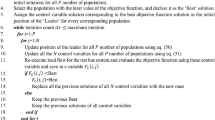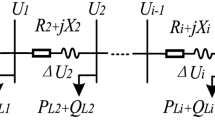Abstract
This paper presents a new analytical method which is derived from a basic power flow equation and then modified for an unbalanced feeder for optimal sizing and sitting of Type-IV DG (A DG which supply active power and in return consume reactive power) at a large scale in an unbalanced distribution system. Introducing a DG that requires reactive power possesses some serious concern with power quality and this situation becomes more venerable when DG is connected in an unbalanced feeder. This is done by identifying the power loss at each node and a new power economy factor which represents exact power loss formulae in terms of economy is formulated for unbalanced feeders considering power loss minimization technique. Further, it is then minimized to acquire the optimal sizing and sitting of DG. For validating the results, IEEE 34 and 123 bus systems unbalanced system was used and it has been found that the proposed method shows significant power loss reduction in the distribution system.










Similar content being viewed by others
References
Pemmada S, Patne NR, Ajay Kumar T, Manchalwar AD (2021) Optimal planning of power distribution network by a novel modified jaya algorithm in multiobjective perspective. IEEE Syst J. https://doi.org/10.1109/JSYST.2021.3132300
Hung DQ, Mithulananthan N, Bansal RC (2010) Analytical expressions for DG allocation in primary distribution networks. IEEE Trans Energy Convers 25(3):814–820
Baran ME, Wu FF (1989) Network reconfiguration in distribution systems for loss reduction and load balancing. IEEE Trans Power Del 4(2):1401–1407
Chis M, Salama MMA, Jayaram S (1997) Capacitor placement in distribution systems using heuristic search strategies. IEE Proc Gener Transm Distrib 144(3):225–230
Haque MH (1999) Capacitor placement in radial distribution systems for loss reduction. IEE Proc Gener Transm Distrib 146(5):501–505
Haque MH (1996) Efficient load flow method for distribution systems with radial or mesh configuration. IEEE Proc Gener Transm Distrib 143(l):33–38
Badran O, Mekhilef S, Mokhlis H, Dahalan W (2017) Optimal reconfiguration of distributionsystem connected with distributed generations: a review of differentmethodologies. Renew Sustain Energy Rev 73:854–867. https://doi.org/10.1016/j.rser.2017.02.010
Wang C, Nehrir MH (2004) Analytical approaches for optimal placement of distributedgeneration sources in power systems. IEEE Trans Power Syst 19:2068–2076. https://doi.org/10.1109/TPWRS.2004.836189
Kumar R, Singh R, Ashfaq H (2020) Stability enhancement of multi-machine power systems using Ant colony optimization-based static Synchronous Compensator. Comput Electr Eng 83:106589
Kumar R, Singh R, Ashfaq H (2020) Stability enhancement of induction generator-based series compensated wind power plants by alleviating subsynchronous torsional oscillations using BFOA-optimal controller tuned STATCOM. Wind Energy 23(9):1846–1867
Kumar R, Singh R, Ashfaq H, Singh S, Badoni M (2021) Power system stability enhancement by dam** and control of Sub-synchronous torsional oscillations using Whale optimization algorithm based Type-2 wind turbines. ISA Trans 108:240–256
Kumar R, Diwania S, Singh R, Ashfaq H, Khetrapal P, Singh S (2021) An intelligent Hybrid Wind–PV farm as a static compensator for overall stability and control of multimachine power system. ISA Trans. https://doi.org/10.1016/j.isatra.2021.05.014
Kumar R, Diwania S, Khetrapal P, Singh S (2021) Performance assessment of the two metaheuristic techniques and their Hybrid for power system stability enhancement with PV-STATCOM. Neural Comput Applic. https://doi.org/10.1007/s00521-021-06637-9
Kumar R, Diwania S, Khetrapal P, Singh S, Badoni M (2021) Multimachine stability enhancement with hybrid PSO-BFOA based PV-STATCOM. Sustain Comput Inform Syst 32:100615. https://doi.org/10.1016/j.suscom.2021.100615
Dharageshwari K, Nayanatara C Multiobjective optimal placement of multipledistributed generations in IEEE 33 bus radial system using simulated annealing. In: IEEE int. conf. circuit power comput. technol ICCPCT 2015. https://doi.org/10.1109/ICCPCT.2015.7159428
Singh S, Chandra KS (2016) Optimal sizing of grid integrated hybrid PV-biomassenergy system using artificial bee colony algorithm. IET Renew Power Gener 10:642–650. https://doi.org/10.1049/iet-rpg.2015.0298
Viral R, Khatod DK (2015) An analytical approach for sizing and siting of DGs in balanced radial distribution networks for loss minimization. Int J Electr Power Energy Syst 67:191–201. https://doi.org/10.1016/j.ijepes.2014.11.017
Ali ES, Abd Elazim SM, Abdelaziz AY (2017) Ant lion optimization algorithm for optimal location and sizing of renewable distributed generations. Renew Energy 101:1311–1324. https://doi.org/10.1016/j.renene.2016.09.023
Zou K, Agalgaonkar AP, Muttai KM, Perera S (2012) Distribution system planning with incorporating DG reactive capability and system uncertainties. IEEE Trans Sustain Energy 3:112–123
Shukla TN, Singh SP, Srinivasarao V, Naik KB (2010) Optimal sizing of distributed generation placed on radial distribution systems. Electr Power Components Syst 38:260–274. https://doi.org/10.1080/15325000903273403
Dong W, Li Y, **ang J (2016) Optimal sizing of a stand-alone hybrid power system based on battery/hydrogen with an improved ant colony optimization. Energies. https://doi.org/10.3390/en9100785
Funding
As a corresponding author of the manuscript, I confirm that neither any funding agency, sponsor, nor any grant associated with the research to declare.
Author information
Authors and Affiliations
Corresponding author
Ethics declarations
Conflict of interest
The authors declare that they have no conflict of interest.
Additional information
Publisher's Note
Springer Nature remains neutral with regard to jurisdictional claims in published maps and institutional affiliations.
Rights and permissions
About this article
Cite this article
Pushkarna, M., Ashfaq, H., Singh, R. et al. A New Analytical Method for Optimal Sizing and Sitting of Type-IV DG in an Unbalanced Distribution System Considering Power Loss Minimization. J. Electr. Eng. Technol. 17, 2579–2590 (2022). https://doi.org/10.1007/s42835-022-01064-9
Received:
Revised:
Accepted:
Published:
Issue Date:
DOI: https://doi.org/10.1007/s42835-022-01064-9




